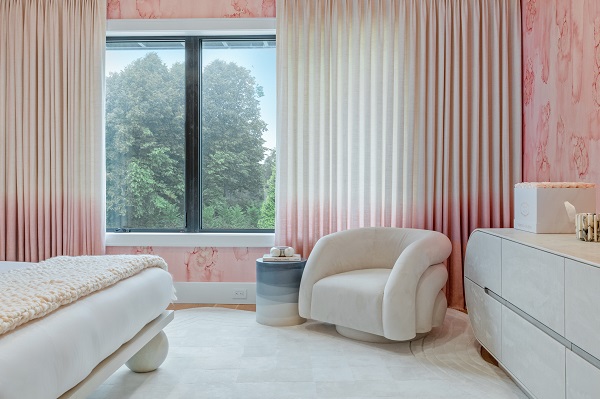By Jana Platina Phipps
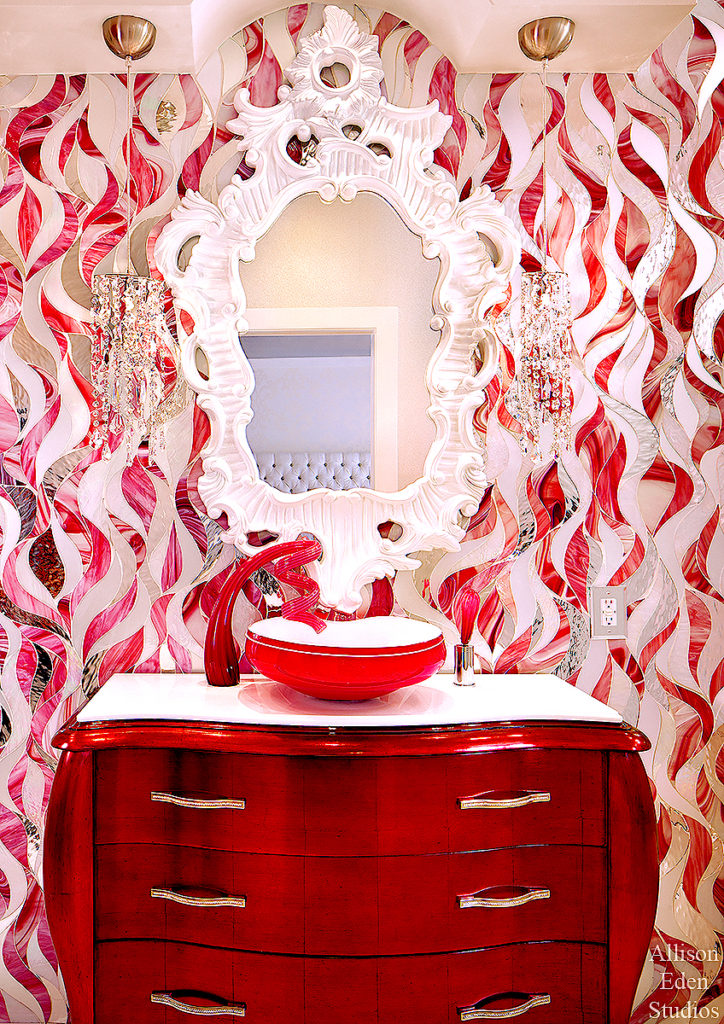
We are having an awakening in design as people everywhere seek authenticity. In a recent survey that we conducted and analyzed with approaches similar to Conjoint analysis (find out What is Conjoint analysis) it was discovered that consumers are increasingly acknowledging the ever-rising cost of “cheap goods”, but want to make a statement against the soulless mass consumption of the past, and that is leading them to reconsider most purchases.
There are many other contributing factors to the desire for authenticity. Aging baby boomers are downsizing and want more meaning from the “things” in their homes. Millennials are living in smaller spaces and carefully curating their furnishings. Author, designer and 50-plus demographic specialist Mitzi Beach writes about this phenomenon in her book “Design Smarts: Inspiration for Home+Life.” “Boomers and Millennials are zestfully seeking experiential living in their homes and in their lifestyles by exercising their status of curation, purchasing unique items that have a backstory. This allows bragging rights so they can impress others with its history and where or from whom they purchased this one-of-a-kind item.”
Above: Mosaic glass artist and product designer Allison Eden creates every pattern as she goes so you will never see a repeat. In her “Waves” pattern, as in all other creations, each glass piece is cut by hand. Photo by Shea Pumarejo.
The evolution of the farm-to-table movement has also opened our eyes to the importance of knowing where our food originates. This awareness has translated to all the goods we consume and even how we travel.
Though this means less consumption on a whole, it creates a rise in “conscious consumption” as a décor trend. This is excellent news for our industry because workrooms are the ateliers of interior design, the couturiers primed to take a bigger share of the design pie. From the artisanal provenance of materials to the exquisite fabrication of custom upholstery and window treatments, suppliers, workrooms and designers are creatively collaborating and catering to this burgeoning consumer craving for authenticity.
Following the latest trends and looking for authenticity might not be a problem as long as you actually require these products. Buying things because they can benefit you in your daily routine while following the trends can be a great method to stay up to date with chic interior and fashion. Moreover, a few products can have health benefits, such as buying a new luxury or chiropedic mattress. Such products can aid in restoring your sleep schedule, reduce aches and pain, and help you achieve proper sleep every day. You can buy the best mattress Australia or near your location from a local seller or online.
Similarly, there could be other interior design elements that people may follow due to those being popular; however, they may have their own benefits that some may neglect. It could be advantageous to carry out in-depth research on products to learn about their positive and negative qualities before going forward with the purchase.
Workroom owner Lisa Salvatore of The Finishing Room in Simsbury, CT, recently collaborated with interior designer Cara Woodhouse with Cara Woodhouse Interiors in Brooklyn, NY, in creating unique high-end drapery for the bedroom of the Holiday House Hamptons. Woodhouse specified a rose quartz ombré alpaca linen fabric hand-loomed in Peru from the Rosemary Hallgarten Collection. “You can see the quality of products so clearly when things are handmade by true artisans,” Woodhouse observes.
Salvatore loved brainstorming with Woodhouse on how to best fabricate the window treatments for a modern, feminine look. “We mocked up sample pleats based on how the exquisite fabric draped. We wanted to take advantage of the soft hand and, in essence, the material inspired the design. The fabric was specified in panels with a feathered (fringed) edge, and the pleats we did required lots of hand stitching. I wish more designers took time to experiment like this.” The results were stunning.
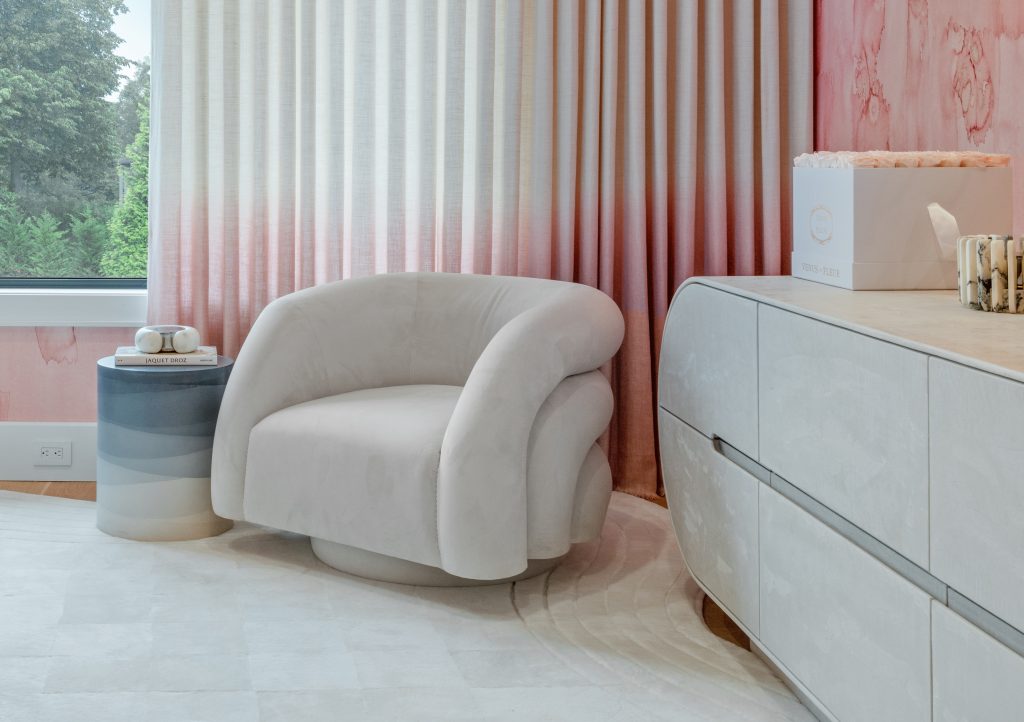
Ombré alpaca by Rosemary Hallgarten is 70 percent alpaca and 30 percent linen. Each fiber takes the dye differently, so it creates a raw, less saturated, natural effect. Photo by Alan Barra for Cara Woodhouse Interiors.
Lisa Salvatore created custom pleats to work with the unique drape of the artisan ombré textile. Salvatore and Woodhouse nicknamed them the “holiday pleats” after the showhouse
The newly launched Frank Ponterio trimmings collection for Clarence House also combines fine materials and takes a sartorial spin on trimmings fabrication. Tapes of pleated wool and linen, woven brass with suede, and braided faux leather constructed in Italy and India create a rough-hewn, menswear style that designers and workrooms will be able to apply thoughtfully to projects.
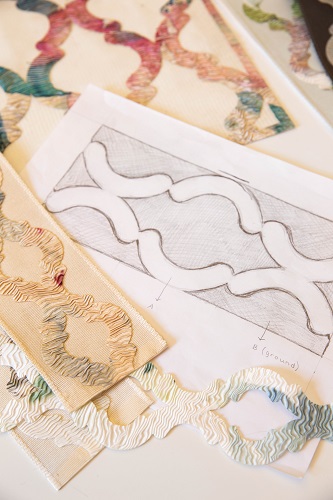
Taking a softer, artistic approach to embellishment is designer Lori Weitzner with her Encore collection for Samuel & Sons. Utilizing modern and age-old techniques, her favorite trim is the Virtuoso tape. “It is a cut pattern that is pleated, digitally printed and then sewn onto a tape. It combines the very contemporary technique of laser cutting with the ancient technique of sewing and appliqué.” (At right: The Virtuoso tape by Lori Weitzner for Samuel & Sons mixes digital printing, laser cut, pleating and appliqué techniques to create a watercolor effect.)
The appreciation for custom-made and artfully unique products has never been higher, claims Brooklyn-based Van Gregory of the Van Gregory & Norton studio. He shares, “Handmade objects have a soul-they carry the energy and enthusiasm of their makers, the texture and feel only hands can generate.” Even after 25 years, the studio continues to experiment, as true artisans do, with materials such as wood, bamboo, cast resin, crystals, textiles, beads, papier-mâché, clay, plaster and wire.
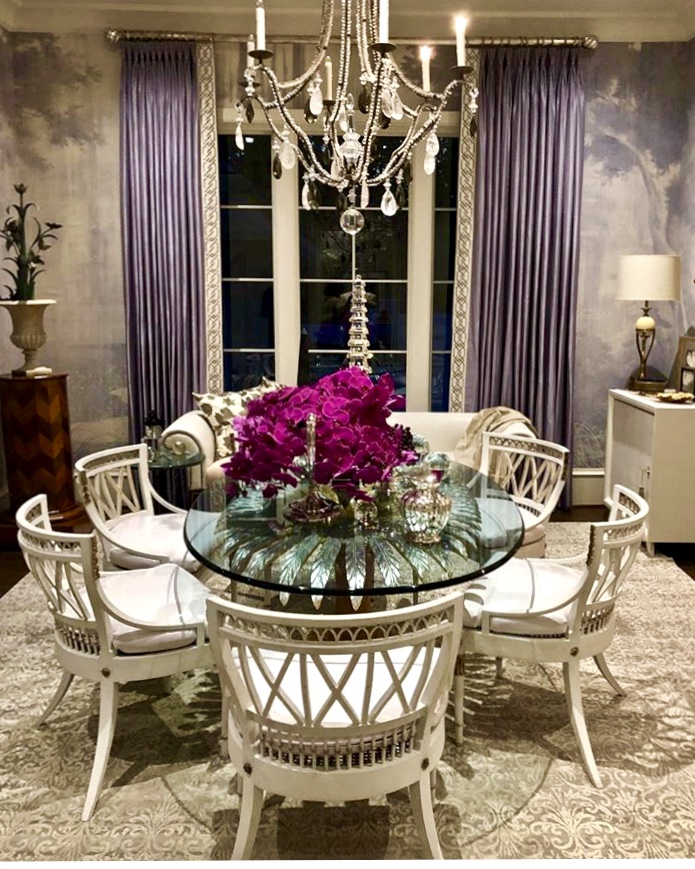
Van Gregory & Norton works with multiple woods and Bolognese gesso depending on the project. They specialize in water and oil gilding in Italian silver leaf, 12K white gold, 16K pale gold, 22K gold leaf, copper and brass leaf, and even Japanese colored leaf. Interior design by Jerry Pair.
Also Brooklyn-based, mosaic glass artist and product designer Allison Eden sees the appreciation of artisans as ongoing. “I don’t think this is a trend-here will always be a market for hand-crafted items, especially for the discerning client. Making mosaics was the first known form of art and we are keeping it fresh, alive and ever-evolving in a machine-made world, innovating in our field.”
With the goal of connecting creatives, the Museum of New Mexico Foundation hosted the third biennial Museum Design Summit last spring. The goal of the summit is three-fold: to educate design professionals about the museum’s extraordinary textile, furniture and ceramic collections; to inspire designers with thoughtful presentations by industry leaders; and to forge new creative partnerships. The Archive Collection-a trimmings collaboration between the Museum of International Folk Art in Santa Fe and Pindler in Southern California-is the result of the summit. Each pattern in the trimmings collection was inspired by a textile or garment in the museum’s 30,000-piece textile collection. The collection was so varied that the museum even considered introducing some digital timeline software to give an accurate idea of what era they all came from. It’s incredible what we have access to these days.
Are you feeling this shift in awareness of authenticity in your work and personal life? I’ve been carefully considering every material, product and thing that crosses my threshold, and my Airbnb account is buzzing with possibilities for my next adventure.
Jana Platina Phipps is well-known as a trimmings designer with a refined vision for the use of trims in home furnishings, fashion and luxury DIY. Affectionately called Trim Queen by her clients, she adopted the moniker and launched her blog, “Trim Queen Chronicles,” in 2013. She now shares inspiration for creativity in modern embellishments daily via her social media channels.


